The article also compares yarn wicks to traditional materials and addresses safety considerations. Additionally, readers will explore different types of yarn that can be used as candle wicks, offering a range of options for experimenting and personalizing their candle experience.
Key Takeaways
– Yarn can be used as a candlewick instead of wood or metal, offering a cleaner burn and no debris.
– Yarn is a natural and biodegradable material, making it an environmentally friendly option for candle wicks.
– Candles should not be left burning for more than four hours to prevent a burned-out wick and faster wax consumption.
– Beeswax is the longest-lasting candle wax option, while paraffin is the cheapest but burns quickly.
The Benefits of Using Yarn as a Candle Wick
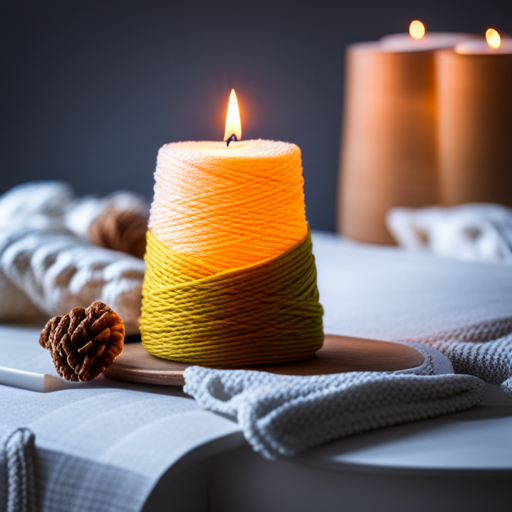
https://www.youtube.com/watch?v=vvdJFTJGJ2k
Using yarn as a candlewick offers the benefits of cleaner burning and a more environmentally friendly option. When compared to traditional wicks made of wood or metal, yarn burns cleaner and doesn’t leave behind debris that can affect the quality of the candle.
Additionally, yarn is a natural material made from plant fibers, making it biodegradable and safe for the environment. By using yarn as a candlewick, individuals can reduce their carbon footprint and contribute to a more sustainable lifestyle.
Not only does yarn provide a cleaner and greener burning experience, but it also offers a unique and creative touch to homemade candles. With a wide variety of colors and textures available, yarn can add a decorative element to any candle-making project.
How to Make a Yarn Candle Wick
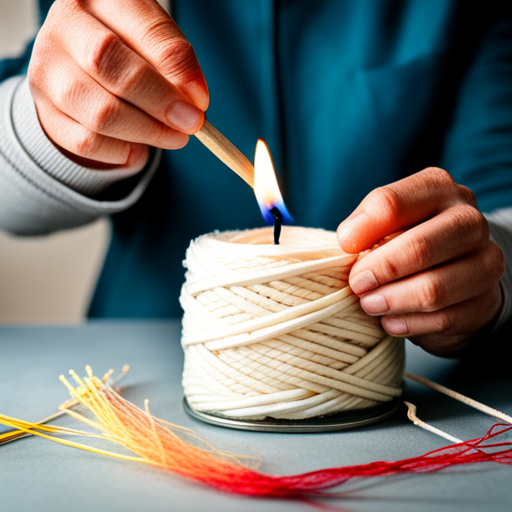
To create a yarn candlewick, one simply needs to wrap a length of yarn tightly around a pencil or dowel and secure the ends with a knot.
It’s a straightforward process that can be done in a few simple steps:
– Choose a pencil or dowel as the base for the candlewick.
– Take a length of yarn and start wrapping it tightly around the pencil or dowel.
– Continue wrapping until you reach the desired thickness for the candlewick.
– Once you’ve reached the desired thickness, secure the ends of the yarn with a knot.
– Trim any excess yarn to ensure a clean and tidy finish.
Tips for Using Yarn as a Candle Wick

Wrapping a length of yarn tightly around a pencil or dowel and securing the ends with a knot creates a homemade candlewick.
Using yarn as a candlewick offers several advantages. First, yarn burns cleaner than traditional wicks and doesn’t leave behind debris that can affect the quality of the candle. Additionally, yarn is a natural material made from plant fibers, making it a biodegradable and environmentally friendly option.
When using yarn as a candlewick, it’s important to trim the wick regularly to prevent it from burning down completely. This helps the candle last longer and prevents the production of black smoke.
Comparing Yarn Wick to Traditional Wick Materials
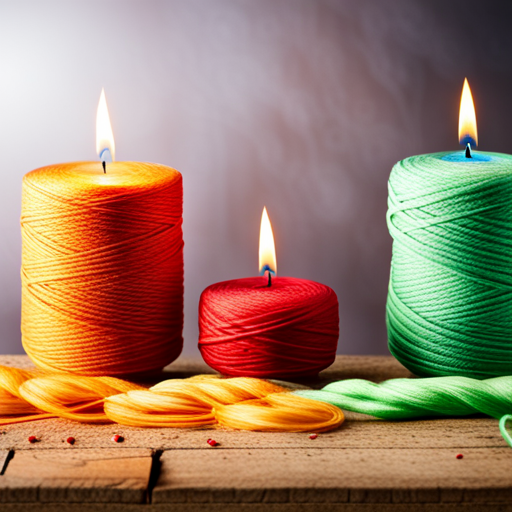
Comparing the yarn wick to traditional wick materials reveals the advantages of using yarn as a candlewick.
– Yarn burns cleaner and produces less debris, resulting in a higher quality candle.
– Yarn is a natural material made from plant fibers, making it a biodegradable and environmentally friendly option.
– Yarn is gentle on the candle and won’t harm its overall structure.
– Yarn is readily available and easy to find in various colors and textures, allowing for creative customization.
– Using yarn as a candlewick provides a unique and rustic aesthetic to candles, adding charm to any space.
Safety Considerations When Using Yarn as a Wick
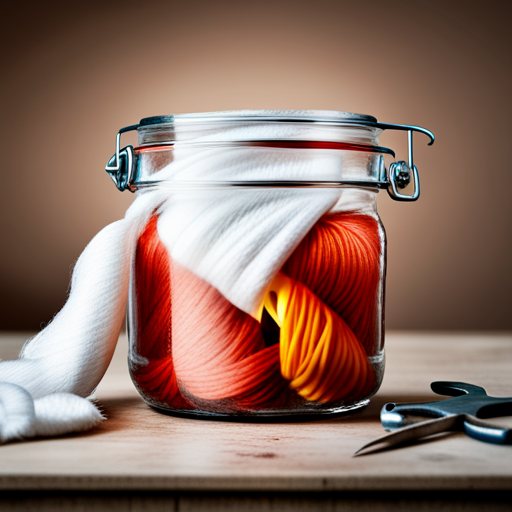
Using yarn as a candlewick requires careful consideration of safety measures to prevent any potential hazards.
While yarn can be a suitable alternative to traditional wick materials, it is important to ensure that the yarn is made of natural fibers and doesn’t contain any synthetic materials that could release harmful fumes when burned.
Additionally, the length and thickness of the yarn should be appropriate for the size of the candle to prevent excessive flame size or uneven burning.
It is also crucial to monitor the candle while it is burning and keep it away from flammable materials, ensuring that it is placed on a stable surface and not left unattended.
Experimenting With Different Yarn Types for Candle Wicks
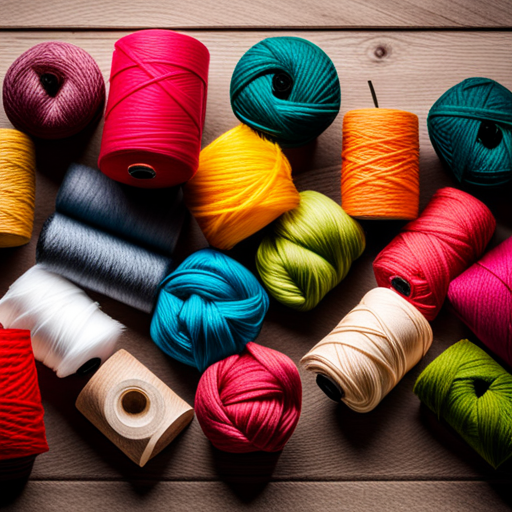
Experimenters have found that testing various types of yarn can lead to different results when used as candle wicks.
– Fine cotton yarn creates a delicate flame that burns steadily and produces minimal smoke.
– Wool yarn produces a larger flame with a cozy ambiance, but may burn faster and produce more soot.
– Bamboo yarn creates a clean and bright flame, ideal for scented candles.
– Acrylic yarn can work as a candle wick, but it tends to burn quickly and may leave behind residue.
– Linen yarn produces a slow-burning flame with minimal smoke, making it suitable for long-lasting candles.
Faqs About Using Yarn as a Candle Wick

Crafters have raised common questions about the use of yarn as a candle wick, such as its burn time and compatibility with different types of candles.
When it comes to burn time, yarn wicks tend to burn for a shorter duration compared to traditional cotton or metal wicks. This is because yarn is not designed specifically for candle burning and may not have the same heat resistance. Additionally, the thickness and composition of the yarn can affect its burn rate.
As for compatibility, yarn wicks may work well with certain types of candles, such as small homemade or decorative candles. However, they may not be suitable for larger or scented candles, as they may not provide a strong enough flame or consistent burn.
It is important for crafters to experiment and test different yarn types and candle combinations to determine the best results.
– Is it Safe to Use Yarn as a Candle Wick in a Wax Warmer?
Using candle wax in warmer requires caution. While some suggest using yarn as a candle wick, it may not be safe. Yarn could catch fire or produce excessive smoke. Opt for a proper candle wick to ensure safety when using candle wax in warmer.
Frequently Asked Questions
Can I Use Any Type of Yarn as a Candle Wick?
Yes, any type of yarn can be used as a candle wick. It burns cleanly, doesn’t leave debris, and is environmentally friendly. Yarn is a natural material that won’t harm the candle.
Will Using Yarn as a Candle Wick Affect the Burn Time of the Candle?
Using yarn as a candle wick may affect the burn time of the candle. The properties of the yarn, such as thickness and material, can impact how quickly the wax melts and how long the candle lasts.
Can I Use Yarn as a Candle Wick in Any Type of Candle?
Yes, yarn can be used as a candle wick in various types of candles. It burns cleanly, doesn’t leave debris, and is an environmentally friendly option.
How Do I Prepare the Yarn to Be Used as a Candle Wick?
To prepare yarn for use as a candle wick, soak it in a solution of borax and salt. After soaking, dry the yarn thoroughly before using it in a candle.
Are There Any Safety Precautions I Should Take When Using Yarn as a Candle Wick?
Safety precautions should be taken when using yarn as a candle wick. Keep the flame away from flammable objects. Monitor the candle while it’s burning and place it on a heat-resistant surface. Follow candle safety guidelines to prevent accidents.

